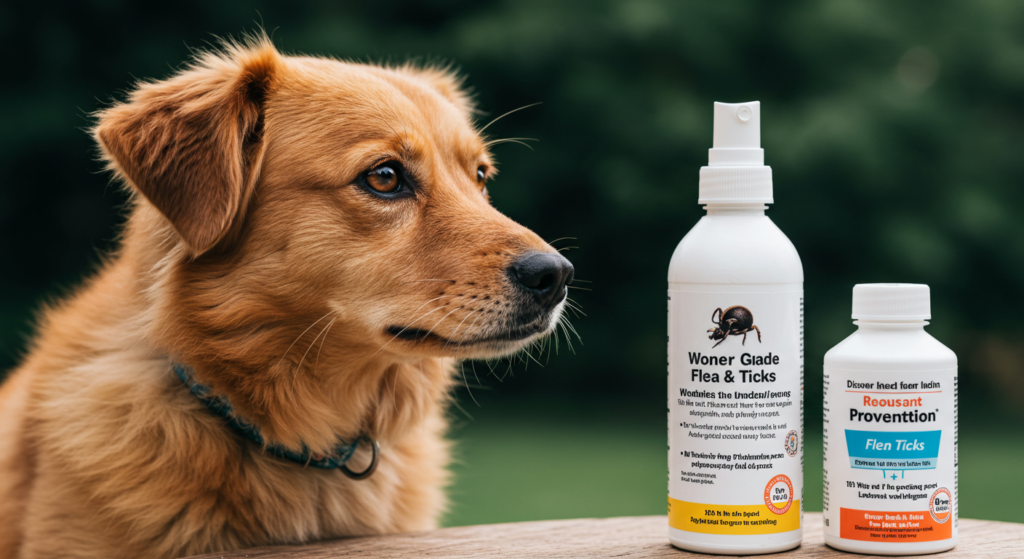Table of Contents
- Introduction
- Why Is Flea and Tick Prevention Important for Dogs?
- When Do Dogs Need Flea and Tick Prevention?
- Choosing a Flea and Tick Combination Medicine for Dogs
- Application Method
- Geography
- Access to the Outdoors
- MDR-1 Gene
- Lifestyle
- Life Stage
- Medical Conditions
- Over-the-Counter vs. Prescription Flea and Tick Medicine
- Popular Dog Flea and Tick Prevention Products
- Advantage® II
- Advantage® Multi
- Conclusion
- FAQs
- Tag List
- Meta Description
Introduction
Flea and tick prevention is a cornerstone of keeping your dog healthy and happy. These tiny parasites can cause significant health issues for your pet, ranging from skin irritation to life-threatening diseases. This guide will walk you through everything you need to know about flea and tick prevention, including why it’s essential, how to choose the right products, and when to start treatment.

Why Is Flea and Tick Prevention Important for Dogs?
Fleas and ticks are ectoparasites that survive by feeding on your dog’s blood. Their bites can lead to severe health problems, including:
- Flea-related issues: Allergies, dermatitis, anemia, itching, and infections.
- Tick-related issues: Infections, abscesses, paralysis, and even death.
These parasites can also transmit diseases to both dogs and humans, such as:
- Lyme disease
- Anaplasmosis
- Bartonellosis
- Rocky Mountain spotted fever
- Tapeworms
- Babesiosis
Preventing fleas and ticks is not just about protecting your dog—it’s about safeguarding your entire household.
When Do Dogs Need Flea and Tick Prevention?
Fleas and ticks are resilient and can thrive in various environments. To ensure your dog’s safety, start flea and tick prevention when they are 8 weeks old and continue year-round throughout their life. This consistent approach helps protect against infestations and the diseases these parasites carry.
Choosing a Flea and Tick Combination Medicine for Dogs
Selecting the right flea and tick preventative involves considering several factors. Here’s what to keep in mind:
1. Application Method
Flea and tick preventatives come in two primary forms:
- Oral: Chewable tablets that your dog ingests.
- Topical: Liquid applied between the shoulder blades or along the back.
Topical treatments are ideal for picky eaters or dogs with sensitive stomachs but require caution around children and other pets. Oral treatments are convenient but must be monitored to ensure your dog doesn’t vomit the medication.
2. Geography
Different regions have varying parasite populations. Use resources like the Companion Animal Parasite Council to identify local risks and choose a product that offers comprehensive protection.
3. Access to the Outdoors
Dogs that spend time in wooded areas, parks, or places frequented by other animals are at higher risk. However, even indoor dogs can be exposed to fleas and ticks, making prevention essential for all pets.
4. MDR-1 Gene
Breeds like Collies, Australian Shepherds, and Shetland Sheepdogs may carry the MDR-1 gene mutation, which affects their ability to process certain medications. Consult your veterinarian to ensure the chosen product is safe for your dog.
5. Lifestyle
Working, herding, and hunting dogs are more likely to encounter fleas and ticks due to their outdoor activities. Tailor your prevention strategy to your dog’s lifestyle.
6. Life Stage
Puppies and small breeds require specific products suited to their weight and age. Most preventatives are safe for dogs over 6 to 8 weeks old, but always verify the label instructions.
7. Medical Conditions
Dogs with a history of seizures or neurological issues should avoid isoxazoline-based products. Always consult your veterinarian if your dog is pregnant, nursing, or has underlying health conditions.
Over-the-Counter vs. Prescription Flea and Tick Medicine
Over-the-Counter (OTC) Products
OTC flea and tick preventatives are widely available and do not require a prescription. While convenient, they may be less effective or safe compared to prescription options. Always consult your veterinarian before using an OTC product.
Prescription Products
Prescription preventatives are typically more effective and safer. They require a veterinarian’s approval and are tailored to your dog’s specific needs.
Popular Dog Flea and Tick Prevention Products
Advantage® II
- Type: Topical
- Active Ingredients: Imidacloprid and pyriproxyfen
- Protection: Kills fleas (eggs, larvae, and adults) and chewing lice. No tick prevention.
- Age/Weight: Dogs over 7 weeks and weighing more than 3 pounds.
Advantage® Multi
- Type: Topical
- Active Ingredients: Imidacloprid and moxidectin
- Protection: Treats fleas, sarcoptic mange, intestinal parasites, and prevents heartworm disease. No tick prevention.
- Age/Weight: Dogs over 7 weeks and weighing more than 3 pounds.
Conclusion
Flea and tick prevention is a vital part of responsible pet ownership. By understanding the risks, choosing the right products, and consulting your veterinarian, you can protect your dog from these harmful parasites and the diseases they carry. Start prevention early, maintain it year-round, and tailor your approach to your dog’s unique needs.
FAQs
1. How often should I apply flea and tick prevention?
Most products are applied monthly, but always follow the specific instructions on the label or from your veterinarian.
2. Can I use dog flea and tick products on cats?
No. Products formulated for dogs can be toxic to cats. Always use species-specific treatments.
3. Are natural flea and tick preventatives effective?
While some natural options may help, they are generally less effective than pharmaceutical products. Consult your veterinarian for recommendations.
4. What should I do if my dog has an adverse reaction to a flea and tick product?
Contact your veterinarian immediately. Symptoms may include vomiting, diarrhea, lethargy, or seizures.
